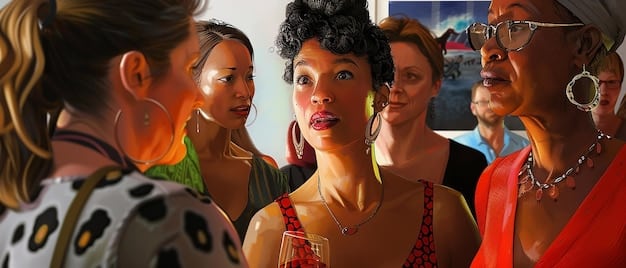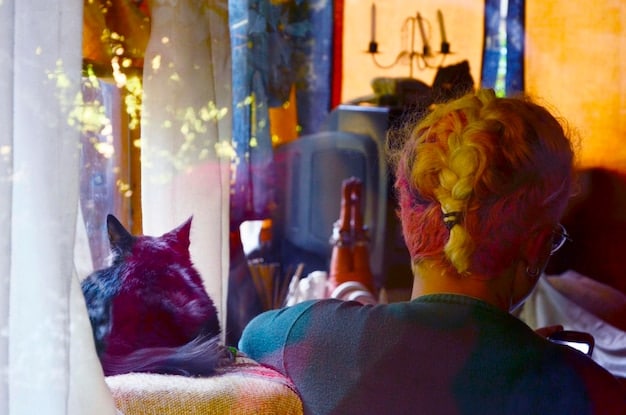The Importance of Diversity in Film: Celebrating Representation on Screen

The Importance of Diversity in Film: Celebrating Representation on Screen highlights how inclusive storytelling enriches cinema, fosters empathy, and reflects the multifaceted experiences of audiences worldwide, promoting a more equitable and representative industry.
The magic of cinema lies not only in its ability to entertain but also in its power to reflect and shape society. At the heart of its cultural influence is the importance of diversity in film: celebrating representation on screen.
Why Diversity in Film Matters
Diversity in film extends beyond mere representation; it’s about creating nuanced, authentic narratives that reflect the richness of human experience. When films include a diverse range of characters, stories, and perspectives, they offer audiences a broader understanding of the world and promote empathy.
Without diverse storytelling, film becomes homogenous, perpetuating stereotypes and limiting the scope of cultural understanding. Inclusive storytelling challenges preconceived notions and fosters a greater appreciation for different cultures, identities, and experiences.

Consider the impact of films like “Black Panther,” which not only shattered box office records but also showcased a predominantly Black cast and crew, telling a story rooted in African culture. Films like this demonstrate that diversity isn’t just morally right; it’s also commercially viable.
Similarly, movies like “Crazy Rich Asians” and “Coco” brought Asian and Latino stories, respectively, to the forefront, resonating with audiences who had long been underrepresented in mainstream media.
Ultimately, embracing diversity in film leads to richer storytelling, greater audience engagement, and a more inclusive cinematic landscape.
Breaking Down Stereotypes Through Film
One of the most significant benefits of diversity in film is its ability to break down stereotypes. For too long, marginalized groups have been depicted inaccurately or incompletely in movies, often perpetuating harmful assumptions. By showcasing authentic representations, films can challenge these stereotypes and promote a more accurate and nuanced understanding of different communities.
Stereotypes in film often stem from a lack of understanding or exposure. When filmmakers are not diverse, they may fall back on familiar tropes instead of delving into the complexities of different cultures and identities.
The Impact of Stereotypical Representations
- Reinforcement of Bias: Stereotypical representations can reinforce existing biases and prejudices, leading to discrimination and marginalization.
- Limited Opportunities: When actors and filmmakers are typecast based on stereotypes, it limits their opportunities and prevents them from showcasing their full range of talent.
- Damaged Self-Esteem: Inaccurate or negative portrayals can damage the self-esteem of individuals and communities who are consistently misrepresented.
By offering multifaceted characters and stories, films can challenge these harmful stereotypes and promote a more equitable and understanding society. Inclusive storytelling demonstrates that people are not defined by their race, gender, or sexual orientation, but rather by their individual experiences and characteristics.
More Authenticity in Storytelling
Authenticity in storytelling is achieved when characters and narratives reflect genuine experiences, cultures, and emotions. Diversity in film plays a pivotal role in fostering authenticity by ensuring that stories are told from a variety of perspectives, free from the constraints of single, dominant viewpoints.
When filmmakers prioritize authenticity, they create narratives that resonate more deeply with audiences, fostering a sense of connection and understanding. Authentic storytelling involves more than just casting diverse actors; it requires a commitment to representing the nuances and complexities of different communities.
How Authenticity Enhances Storytelling
- Deeper Audience Connection: Authentic stories are more relatable and emotionally resonant, allowing audiences to connect with characters and narratives on a deeper level.
- Challenging Perspectives: By presenting different viewpoints, authentic storytelling challenges preconceived notions and encourages audiences to consider alternative perspectives.
- Cultural Preservation: Authentic representations help preserve and celebrate different cultures, promoting greater appreciation and understanding.
Furthermore, authenticity in storytelling requires a commitment to historical accuracy, cultural sensitivity, and thoughtful character development. By prioritizing these elements, filmmakers can create stories that are both engaging and meaningful.

The Financial Benefits of Diverse Films
While the moral and social arguments for diversity in film are compelling, it’s also essential to recognize the financial benefits. Studies and box office trends consistently demonstrate that diverse films often perform better financially than those with homogenous casts and crews.
One reason for this phenomenon is that diverse films appeal to a broader audience. When different communities see themselves represented on screen, they are more likely to support the film and encourage others to do the same.
Moreover, diverse perspectives can lead to innovative storytelling and fresh creative ideas, which can help a film stand out in a competitive market. Films that cater to specific cultural niches can also tap into underserved markets, generating significant revenue.
For instance, “Black Panther” not only grossed over $1.3 billion worldwide but also sparked a cultural movement, demonstrating the power of representation in driving financial success. Similarly, films like “Get Out” and “Hidden Figures” proved that diverse stories can resonate with mainstream audiences and achieve critical acclaim.
Ultimately, investing in diverse films is not just a matter of social responsibility; it’s also a smart business decision.
Increasing Representation Behind the Camera
While on-screen representation is crucial, equal importance needs to be given to increasing diversity in film behind the camera. This includes directors, writers, producers, cinematographers, and other key creative roles. When diverse voices are involved in the production process, it leads to more authentic and nuanced storytelling.
For too long, the film industry has been dominated by a select group of individuals, resulting in a limited range of perspectives. By actively promoting diversity behind the camera, the industry can ensure that films reflect the experiences of a wider range of communities.
Initiatives such as mentorship programs, scholarships, and targeted recruitment efforts can help break down barriers and create opportunities for underrepresented groups in the film industry. Additionally, studios and production companies can implement policies that prioritize diversity in hiring and promotion.
When diverse creative teams are empowered to tell their stories, it leads to richer, more innovative films that resonate with a broader audience.
Advantages of Diverse Creative Teams
- Enhanced Creativity: Diverse teams bring a wider range of perspectives and experiences, leading to more creative and innovative solutions.
- Authentic Storytelling: When stories are told by people who have lived those experiences, they are more likely to be authentic and nuanced.
- Broader Audience Appeal: Films created by diverse teams are more likely to appeal to a wider range of audiences, leading to greater financial success.
Increasing diversity behind the camera is not just a matter of social justice; it’s also a crucial step in creating a more vibrant and inclusive film industry.
The Impact of Diversity on Future Generations
The films people watch today shape the perceptions and aspirations of future generations. Diversity in film is crucial for creating a more inclusive and equitable society by showing young people that their stories matter and that they can aspire to anything, regardless of their background.
When children see themselves represented on screen, it validates their experiences and fosters a sense of belonging. It helps them understand that their stories are worth telling and that they can make a difference in the world.
Conversely, when children from marginalized communities are consistently underrepresented or misrepresented in films, it can lead to feelings of isolation and low self-esteem. It can also reinforce harmful stereotypes and limit their aspirations.
By showcasing diverse role models and stories, films can inspire young people to dream big and pursue their goals. It can also help them develop empathy and understanding for people from different backgrounds.
The Role of Film in Shaping Perceptions
- Promoting Empathy: Films can help young people develop empathy by exposing them to different perspectives and experiences.
- Challenging Stereotypes: By showcasing authentic representations, films can challenge harmful stereotypes and promote a more nuanced understanding of different communities.
- Inspiring Aspirations: Films can inspire young people to dream big and pursue their goals by showcasing diverse role models and stories.
Investing in diverse films is an investment in the future. It’s a way to create a more inclusive and equitable society for generations to come.
| Key Point | Brief Description |
|---|---|
| Representation Matters 🎬 | Inclusive storytelling allows diverse audiences to see themselves reflected on screen. |
| Breaking Stereotypes 🚫 | Challenging harmful stereotypes through authentic and nuanced portrayals. |
| Financial Success 💰 | Diverse films often achieve greater financial success by appealing to wider audiences. |
| Behind-the-Camera Voices 🎥 | Increasing diversity among directors, writers, and producers for authentic storytelling. |
FAQ
▼
Diversity ensures varied perspectives, breaking stereotypes and enriching narratives. It also allows for wider audiences to connect with the stories being told and presented, leading to a more inclusive cultural landscape.
▼
The film industry can enhance diversity through inclusive hiring practices, funding diverse projects, and offering mentorships. It is also important to support diverse talent both on and off the screen.
▼
Diverse storytelling broadens understanding, promotes empathy, and enriches perspectives. Moreover, it can lead to more authentic stories and resonate more deeply with audiences.
▼
Viewers can support diverse film by attending screenings, streaming inclusive content, and advocating for diverse stories. The choices of the consumers drive the industry’s direction and offerings.
▼
Diversity behind the camera ensures authentic representations, varied perspectives, and richer narratives. Diverse creative teams can avoid stereotypes and provide nuanced portrayals, leading to improved film quality.
Conclusion
Embracing the importance of diversity in film: celebrating representation on screen is essential for creating a more inclusive, equitable, and culturally rich society. By prioritizing diverse stories and voices, the film industry can not only entertain but also inspire and educate audiences worldwide, paving the way for a brighter future.





